 Introduction
Introduction
 Annual Maintenance
Annual Maintenance
 Periodic
Maintenance
Periodic
Maintenance
The first step toward having a beautiful, sustainable lawn
is to select a turfgrass variety adapted for your area. The next step is proper
establishment. A quality turfgrass variety properly established is easier to
maintain and enjoy. Important factors in maintaining quality turfgrass include
regular mowing, fertilization, weed control, irrigation, and leaf-raking. In
some years, dethatching, pH adjustment, aeration, disease control, and insect
control may be beneficial.
Return to Table of Contents
Mowing. Frequent mowing is an important part of turf maintenance. It
is best to remove no more than one third of the vegetation at one mowing. If
mowed too closely, root growth is slowed. This reduces the lawn's tolerance to
heat and drought. Also, weeds are more likely to invade closely cut lawns.
Recommended mowing heights for turfgrasses
|
Turfgrass |
Mowing Heights (inches) |
|
Kentucky bluegrass |
11/2 to 21/2 |
|
Tall fescue |
2 to 3 |
|
Creeping red fescue |
2 to 3 |
|
Perennial ryegrass |
11/2 to 21/2 |
|
Bermudagrass |
1/2, to 1 |
|
Zoysiagrass |
3/4 to 1 |
Selecting higher mowing heights during summer months for cool-season grasses
will reduce stress levels of the turf: at the same time, it will increase the
likelihood of the grass surviving drought. Lower mowing heights in fall will aid
leaf collection.
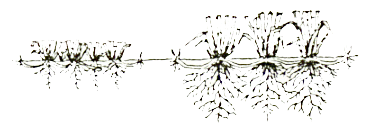 Be sure to keep your mower blade sharp!
Using a dull blade causes excess leaf damage and depletes the plant's stored
reserves during the stress-filled summer months. Eventually the plant is not
able to heal the mowing wound. The open wound becomes a site of fungal entry,
leading to a diseased lawn.
Be sure to keep your mower blade sharp!
Using a dull blade causes excess leaf damage and depletes the plant's stored
reserves during the stress-filled summer months. Eventually the plant is not
able to heal the mowing wound. The open wound becomes a site of fungal entry,
leading to a diseased lawn.
Clippings can be effectively recycled to the turf as long as they disperse
well and are not clumped on the lawn. They are not a major contributor to
thatch, and they provide nutrition to the lawn as they decompose.
Fertilization. Fall fertilization enhances the quality of cool-season
grasses in Virginia. The advantages of fall fertilization include better density
and root growth, less spring mowing, better fall-to-spring color, less weed
problems, better drought tolerance, and less summer disease activity. The amount
of fertilizer to apply and the timing of application can affect both turf and
groundwater quality. Contact your local Extension agent or nursery expert for
recommendations.
pH Adjustment. Soils in Virginia are typically acid, and it may be
necessary to add lime occasionally to keep the soil pH near 6.2, the ideal for
quality turfgrass. A soil test every two to three years will tell how much lime
to apply.
Irrigation. Deep, infrequent irrigation (so water penetrates 6 to 8
inches deep) will encourage deep root growth, efficient water use, and turfgrass
quality. The best time to water a lawn is early morning when evaporation is
minimized. Early evening or night watering leaves the lawn wet at night, which
increases the potential for disease.
A light sprinkling of the surface encourages root development near the
surface and increases weed seed germination. The resulting, limited root system
will require frequent watering and constant surface moisture.
Lawns can use an inch or more of water per week in hot, dry weather. If
rainfall does not provide this much water, the lawn should be watered when the
soil begins to dry out, but before the grass actually wilts (areas of the lawn
will begin to turn blue-green). If you choose not to water, Kentucky bluegrass
can be allowed to go dormant (turns straw-colored and stops growing). It can
stay that way until rainfall returns and the grass naturally greens up again.
While dormancy is a natural method of drought survival of Kentucky bluegrass,
many fluctuations between dormancy and active growth weaken the lawn. Watering
during the fall when more favorable growing conditions exist and evaporation is
less encourages recovery of the lawn. Tall fescue has a deep root system in
deep, well-drained soils and can survive moderate drought periods.
Return to Table of Contents
Dethatching. In some years it may be necessary to remove thatch - the
tightly interwoven layer of living and dead stems, leaves, and roots between the
green grass and the soil surface. A layer of thatch less than a half inch in
thickness can be beneficial to the grass, as it is similar to mulch and provides
many of the same benefits. Too much thatch provides a habitat for insects and
disease and makes the grass less tolerant of heat and drought.
If the lawn's thatch is more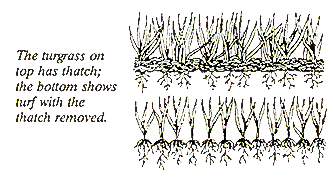 than a
half-inch thick, dethatching will be beneficial. Timing is critical; dethatching
should be done during low-stress periods. Kentucky bluegrass and other
cool-season grass lawns should be dethatched in early fall or early spring.
Bermudagrass and zoysiagrass should be dethatched June through July. Dethatchers
can be rented; they deposit the thatch debris on top of the lawn, where it can
be raked up and composted.
than a
half-inch thick, dethatching will be beneficial. Timing is critical; dethatching
should be done during low-stress periods. Kentucky bluegrass and other
cool-season grass lawns should be dethatched in early fall or early spring.
Bermudagrass and zoysiagrass should be dethatched June through July. Dethatchers
can be rented; they deposit the thatch debris on top of the lawn, where it can
be raked up and composted.
Aeration. If soil is heavy or compacted, or thatch is a problem,
aeration may be necessary. Roots need oxygen as well as water and nutrients;
compacted soil prevents the flow of oxygen from the atmosphere to the roots.
Aeration is best done by a machine which forces hollow metal tubes into the
ground and brings up small cores of soil. When this is done, the soil should be
moist ‚ neither too wet nor too dry. Other "aerators" punch holes in the soil
with a spiked roller; while they may aid water retention, they actually increase
soil compaction. Soils are aerated during the same seasons as dethatching.
Weed Control. Weed control can be minimized by good mowing and
fertilization management, which help grass compete with weeds. Broadleaf or
grassy weeds can be perennial, annual, or biennial. Control methods and timing
vary depending on the weed species.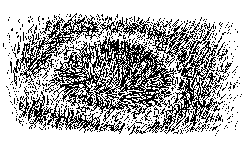
Disease Control. Proper management will greatly reduce a lawn's
susceptibility to disease. Disease damage may be difficult to identify since
many of the same symptoms are also caused by bad management or by natural
factors, such as competition from tree roots. Most lawn diseases are caused by
fungi; fungicides can be applied to control them.
Insect Control. Many types of insects occur naturally in a lawn; most
of them are not harmful and do not require control unless the pest population
builds up enough to cause visible damage. Close examination of the turfgrass is
the most effective way to identify insects.
The most common above-ground insect pests in Virginia lawns are chinch bugs
and sod webworms; both feed on grass leaves and stems. Below ground, the most
common pests are white grub larvae and weevil or billbug grubs; these feed on
plant stems and roots.
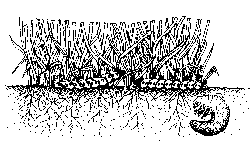 If a problem is evident, your Extension
agent can help identify the pest and suggest controls.
If a problem is evident, your Extension
agent can help identify the pest and suggest controls.
Return to Table of Contents
![]() Gardeners' Corner
Kids'
Garden
Sustainable Garden
Contact Us
Gardeners' Corner
Kids'
Garden
Sustainable Garden
Contact Us![]()
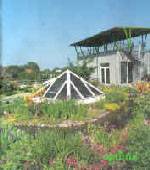
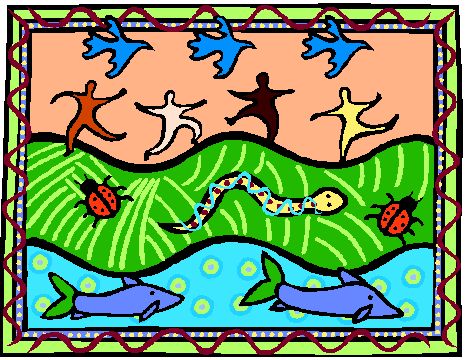

 Be sure to keep your mower blade sharp!
Using a dull blade causes excess leaf damage and depletes the plant's stored
reserves during the stress-filled summer months. Eventually the plant is not
able to heal the mowing wound. The open wound becomes a site of fungal entry,
leading to a diseased lawn.
Be sure to keep your mower blade sharp!
Using a dull blade causes excess leaf damage and depletes the plant's stored
reserves during the stress-filled summer months. Eventually the plant is not
able to heal the mowing wound. The open wound becomes a site of fungal entry,
leading to a diseased lawn.  than a
half-inch thick, dethatching will be beneficial. Timing is critical; dethatching
should be done during low-stress periods. Kentucky bluegrass and other
cool-season grass lawns should be dethatched in early fall or early spring.
Bermudagrass and zoysiagrass should be dethatched June through July. Dethatchers
can be rented; they deposit the thatch debris on top of the lawn, where it can
be raked up and composted.
than a
half-inch thick, dethatching will be beneficial. Timing is critical; dethatching
should be done during low-stress periods. Kentucky bluegrass and other
cool-season grass lawns should be dethatched in early fall or early spring.
Bermudagrass and zoysiagrass should be dethatched June through July. Dethatchers
can be rented; they deposit the thatch debris on top of the lawn, where it can
be raked up and composted. 
 If a problem is evident, your Extension
agent can help identify the pest and suggest controls.
If a problem is evident, your Extension
agent can help identify the pest and suggest controls.